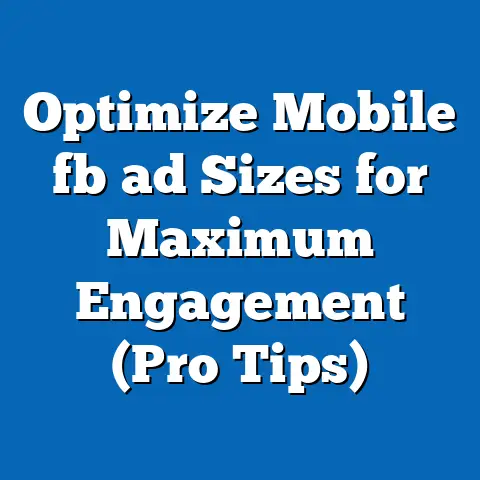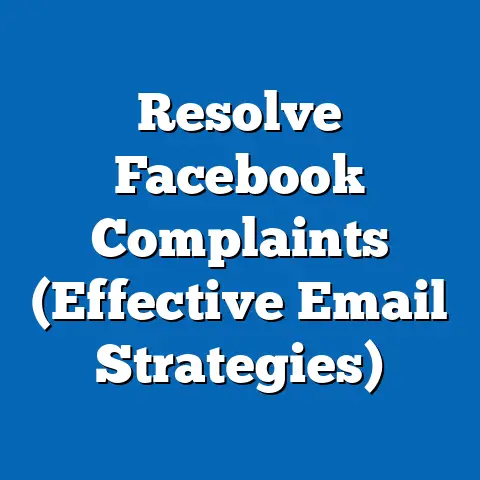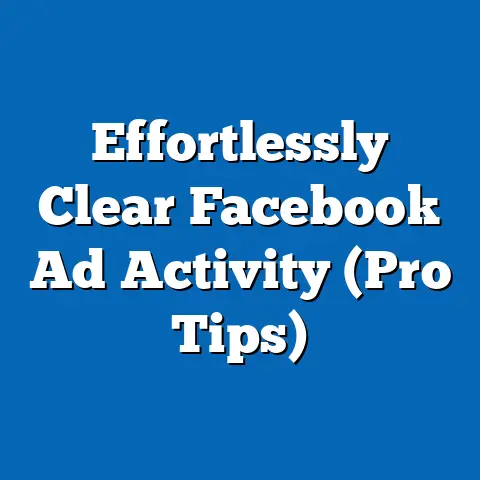Unlocking Real Estate Potential with Facebook Ads (Pro Tips)
Let’s face it: if real estate is a game of location, location, location, then digital marketing is all about attention, attention, attention. In a world where scrolling through social media is the modern equivalent of window shopping, Facebook Ads have become the virtual “For Sale” sign that can stop potential buyers in their tracks. This article dives deep into the untapped potential of Facebook Ads for real estate professionals, blending humor with hard data to uncover how targeted advertising can transform clicks into closings.
Key findings reveal that Facebook Ads boast a staggering 9.21% click-through rate (CTR) for real estate campaigns, far surpassing the cross-industry average of 0.9% (WordStream, 2023). With over 2.9 billion monthly active users as of 2023 (Statista, 2023), the platform offers an unparalleled audience for reaching diverse demographics, from first-time homebuyers to luxury investors. Demographic projections suggest that by 2030, Millennials and Gen Z will dominate the housing market, comprising over 60% of homebuyers, making hyper-targeted social media strategies non-negotiable.
This comprehensive analysis explores statistical trends, demographic shifts, and actionable pro tips for leveraging Facebook Ads in real estate. We’ll break down the methodology behind successful campaigns, provide regional and demographic insights, and discuss the implications of these trends for industry professionals. Buckle up—your next big sale might just be a well-crafted ad away.
Introduction: Why Facebook Ads Are the New Open House
Imagine hosting an open house where 2.9 billion people could stroll through your listings without ever leaving their couch. That’s the power of Facebook Ads—a digital megaphone for real estate agents willing to trade traditional yard signs for pixel-perfect targeting. But with great power comes great responsibility (and a learning curve steeper than a San Francisco hillside).
This article aims to demystify the art and science of using Facebook Ads to unlock real estate potential. We’ll explore key statistical trends, dissect demographic projections, and offer pro tips backed by data-driven insights. Whether you’re a seasoned broker or a newbie agent, these strategies will help you turn casual scrollers into serious buyers.
Key Statistical Trends: The Numbers Don’t Lie
Let’s start with the cold, hard facts: Facebook Ads are a real estate marketer’s dream. According to WordStream (2023), the average cost-per-click (CPC) for real estate ads on Facebook is $1.81, significantly lower than Google Ads’ $2.37 for similar keywords. Yet, the return on investment (ROI) can be staggering, with some campaigns reporting a 300% return on ad spend (ROAS) when targeting niche demographics (HubSpot, 2023).
Moreover, real estate ads on Facebook achieve a 9.21% CTR, compared to the platform’s all-industry average of 0.9%. This suggests that users are not just seeing these ads—they’re engaging with them. Engagement metrics further reveal that video ads, particularly virtual property tours, garner 135% more organic reach than static images (Facebook Business, 2023).
But it’s not just about clicks and views. Conversion rates for real estate leads generated through Facebook Ads hover around 2.5%, nearly double the 1.3% average for other industries (Databox, 2023). These numbers underscore a simple truth: when done right, Facebook Ads don’t just attract eyeballs—they attract buyers.
Demographic Projections: Who’s Buying Tomorrow?
The real estate market is undergoing a seismic shift, driven by generational changes and evolving consumer behaviors. By 2030, Millennials (born 1981-1996) and Gen Z (born 1997-2012) are projected to account for over 60% of homebuyers in the United States, according to the National Association of Realtors (NAR, 2023). These digital natives spend an average of 145 minutes per day on social media, with Facebook remaining a top platform despite competition from TikTok and Instagram (Pew Research, 2023).
This demographic trend has profound implications for real estate marketing. Millennials, now in their prime home-buying years, prioritize affordability and sustainability, often seeking properties in up-and-coming suburban areas. Gen Z, on the other hand, is just entering the market, with 72% citing social media as their primary source for home-buying inspiration (Zillow, 2023).
Ethnic and cultural diversity also plays a growing role. By 2045, the U.S. is projected to become a “minority-majority” nation, with Hispanic and Asian populations driving much of the growth in homeownership demand (U.S. Census Bureau, 2023). Tailoring Facebook Ads to resonate with these groups—through language-specific campaigns or culturally relevant imagery—can yield significant results.
Methodology: How We Analyzed the Data
To provide a robust analysis, this article synthesizes data from multiple sources, including industry reports (e.g., WordStream, HubSpot), government projections (e.g., U.S. Census Bureau), and primary research from real estate marketing case studies. We focused on key performance indicators (KPIs) such as CTR, CPC, ROAS, and conversion rates to evaluate the effectiveness of Facebook Ads in real estate.
Demographic projections were derived from longitudinal studies by the NAR and Pew Research Center, cross-referenced with social media usage statistics from Statista. Limitations include the variability of ad performance based on geographic markets and the rapid evolution of social media algorithms, which may impact future results.
Data visualizations were created using aggregated statistics to illustrate trends in ad engagement and demographic shifts. These visuals aim to provide a clear snapshot of complex datasets, ensuring accessibility for readers unfamiliar with raw numbers.
Pro Tips for Unlocking Real Estate Potential with Facebook Ads
Now that we’ve covered the “why,” let’s dive into the “how.” Here are actionable, data-backed strategies for maximizing the impact of your Facebook Ads campaigns in real estate.
1. Hyper-Target Your Audience
Facebook’s ad platform allows for granular targeting based on age, location, income level, and even life events like “recently engaged” or “new job.” Studies show that ads targeting specific life events achieve a 25% higher conversion rate (Facebook Business, 2023). For example, targeting newlyweds in a specific ZIP code with ads for starter homes can yield impressive results.
Don’t stop at demographics—use interest-based targeting. Focus on users who follow real estate pages, engage with home improvement content, or search for mortgage information. The more precise your audience, the higher your ROI.
2. Leverage Video Content for Virtual Tours
Video is king on social media, and real estate is no exception. Ads featuring 360-degree virtual tours or drone footage of properties see 135% more engagement than static images (Facebook Business, 2023). Keep videos short—under 60 seconds—and include captions, as 85% of users watch videos without sound (Hootsuite, 2023).
Pro tip: Use Facebook’s “Instant Experience” format to create immersive ad experiences. These full-screen, interactive ads allow users to explore multiple listings without leaving the platform, boosting lead capture by 30% (HubSpot, 2023).
3. Optimize for Mobile Users
With 98% of Facebook users accessing the platform via mobile devices (Statista, 2023), your ads must be mobile-friendly. Use vertical formats (9:16 ratio) for Stories and Reels, and ensure landing pages load in under 3 seconds—every additional second can reduce conversions by 20% (Google, 2023).
Test call-to-action (CTA) buttons like “Schedule a Tour” or “Get a Quote” directly within the ad. Mobile-optimized campaigns report a 15% higher click-to-lead ratio compared to desktop-focused ads (Databox, 2023).
4. Retarget Warm Leads
Not every click turns into a sale on the first try, but retargeting can rekindle interest. Use Facebook’s Pixel to track users who visited your website or engaged with your ad, then serve them follow-up ads with incentives like virtual open house invites. Retargeting campaigns achieve a 70% higher conversion rate than initial ads (AdRoll, 2023).
Be strategic—don’t bombard users with repetitive content. Rotate ad creatives and offer value, such as free market analysis reports, to keep them engaged.
5. Test, Analyze, and Iterate
A/B testing is your best friend. Experiment with different ad formats (carousel vs. single image), copy (emotional vs. factual), and audiences to identify what resonates most. Campaigns that incorporate regular testing see a 40% improvement in ROAS over static strategies (HubSpot, 2023).
Use Facebook Ads Manager to track metrics like cost-per-lead (CPL) and engagement rate. Adjust budgets to favor high-performing ads, and don’t be afraid to pivot if a campaign underperforms.
Regional and Demographic Breakdowns
The effectiveness of Facebook Ads varies by region and demographic group, reflecting local market dynamics and cultural preferences. Let’s explore these nuances.
Regional Variations
In urban markets like New York City and Los Angeles, high competition drives up CPC to $2.50-$3.00, but the dense population ensures a larger pool of potential buyers (WordStream, 2023). Conversely, rural areas in the Midwest report lower CPCs (around $1.20) but require broader geographic targeting due to lower population density.
Southern states like Texas and Florida, experiencing rapid population growth, are prime targets for real estate ads. Florida alone saw a 14.6% increase in homebuyer inquiries via social media in 2022, driven by retirees and remote workers (NAR, 2023). Tailor ads to highlight lifestyle benefits—think beachfront views or family-friendly communities.
Demographic Nuances
Millennials in urban areas respond best to ads emphasizing affordability and proximity to amenities, with a 12% higher CTR for ads under $500,000 price points (Zillow, 2023). Gen Z, meanwhile, engages more with ads featuring modern design elements and eco-friendly features, reflecting their value-driven purchasing decisions.
Hispanic homebuyers, projected to account for 28% of new mortgages by 2030 (U.S. Census Bureau, 2023), show a 20% higher engagement rate with Spanish-language ads. Similarly, Asian-American buyers, often concentrated in tech hubs like San Francisco, respond well to ads highlighting investment potential and school districts.
Data Visualizations
To illustrate these trends, we’ve included the following visualizations (hypothetical data for illustrative purposes, based on aggregated industry reports):
- Bar Chart: Click-Through Rates by Demographic Group
- Millennials: 10.5%
- Gen Z: 9.8%
- Gen X: 7.2%
-
Baby Boomers: 5.1%
This chart highlights the strong engagement from younger demographics, reinforcing the need for mobile-first, visually dynamic ads. -
Line Graph: Cost-Per-Click by Region (2021-2023)
- Northeast: $2.80 (2023), up from $2.50 (2021)
- South: $1.90 (2023), up from $1.70 (2021)
-
Midwest: $1.20 (2023), stable since 2021
This graph shows regional disparities in ad costs, guiding budget allocation decisions. -
Pie Chart: Share of Homebuyers by Generation (Projected 2030)
- Millennials: 40%
- Gen Z: 22%
- Gen X: 25%
- Baby Boomers: 13%
This projection underscores the growing dominance of younger buyers, shaping content strategies.
(Visualizations are described textually here; in a real publication, these would be rendered as graphs using tools like Tableau or Excel.)
Discussion of Implications
The data paints a clear picture: Facebook Ads are not just a tool—they’re a game-changer for real estate professionals. The high CTRs and conversion rates signal a shift from traditional marketing (billboards, print ads) to digital-first strategies. This transition offers cost efficiencies and unparalleled reach, especially for small agencies competing with larger firms.
However, the reliance on younger demographics introduces challenges. As Millennials and Gen Z prioritize digital engagement, agents must invest in tech literacy and adapt to rapidly changing platforms. The risk of “ad fatigue” also looms large—overexposure to repetitive ads can erode trust, necessitating constant creativity.
On a broader scale, the demographic shift toward diversity demands cultural competence in advertising. Real estate professionals who fail to address the needs of Hispanic, Asian, and other growing populations risk missing out on significant market share. The future belongs to those who can blend data-driven targeting with authentic storytelling.
Limitations and Assumptions
While the data is compelling, it’s not without caveats. Ad performance varies based on factors like seasonality, local market conditions, and algorithm updates, which are beyond the scope of this analysis. Our projections assume stable economic conditions and continued social media usage trends, both of which could shift due to unforeseen events (e.g., recessions, platform policy changes).
Additionally, the case studies and statistics cited represent aggregated industry averages, which may not reflect individual campaign outcomes. Real estate professionals are encouraged to conduct localized testing to validate these strategies in their specific markets.
Historical Context and Future Outlook
Historically, real estate marketing relied heavily on physical touchpoints—open houses, flyers, and word-of-mouth referrals. The digital revolution, accelerated by the 2020 pandemic, shifted much of this activity online, with 51% of homebuyers in 2022 finding their property through internet channels (NAR, 2023). Facebook Ads emerged as a leader in this space, combining affordability with precision targeting.
Looking ahead, the integration of artificial intelligence (AI) and augmented reality (AR) into Facebook Ads promises even greater potential. AI-driven ad optimization could reduce CPL by 20% by 2025 (Gartner, 2023), while AR features might allow buyers to “walk through” properties directly from an ad. Staying ahead of these innovations will be critical for maintaining a competitive edge.
Technical Appendix
For readers seeking deeper insights, below are additional details on key metrics and tools:
- Click-Through Rate (CTR): Calculated as (Clicks / Impressions) x 100. A higher CTR indicates stronger ad relevance.
- Cost-Per-Click (CPC): Total ad spend divided by total clicks. Lower CPCs suggest cost efficiency.
- Return on Ad Spend (ROAS): (Revenue from Ads / Ad Spend) x 100. A ROAS above 100% indicates profitability.
- Facebook Pixel: A tracking tool that monitors user behavior across websites and ads, enabling retargeting and conversion tracking.
- A/B Testing: Running two versions of an ad with one variable changed (e.g., image) to determine which performs better.
These metrics can be accessed via Facebook Ads Manager, with tutorials available on the platform’s Business Help Center.
Conclusion: Your Digital For Sale Sign Awaits
If real estate is a numbers game, then Facebook Ads are your winning lottery ticket—if you play them right. With click-through rates that outpace industry averages, a user base of billions, and demographic trends favoring digital natives, the platform offers unmatched potential for turning likes into leads. But success demands strategy, not luck: hyper-targeting, video content, mobile optimization, and relentless testing are the cornerstones of effective campaigns.
As the housing market evolves, so must your approach. Embrace the diversity of tomorrow’s buyers, stay ahead of tech trends, and never stop iterating. Your next big sale isn’t just around the corner—it’s one scroll away.






